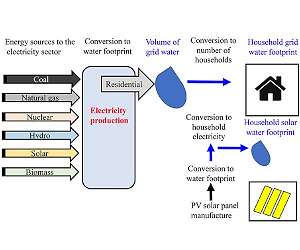With global energy-related carbon dioxide emissions reaching an all-time high in 2021, the need for clean energy is more pressing than ever. One such alternative to fossil fuels is solar energy. Solar cells have been developed with a variety of materials, but selenium (Se) is a desirable option because it is low-cost, stable and nontoxic, according to Chao Chen of the Wuhan National Laboratory for Optoelectronics (WNLO) and School of Optical Electronic Information at Huazhong University of Science and Technology, China.
However, its efficiency is limited by its low melting point and wide bandgap-or range where no electronic states can exist. Now, Chen and other researchers have overcome these limitations by alloying selenium with tellurium (Te), making selenium solar cells a more attractive option.
The researchers published their results in Frontiers of Optoelectronics in September 2022.
The optimal bandgap range for single-junction solar cells is 1-1.5 eV, according to the researchers, but Se’s bandgap is about 1.8 eV, making it broader than ideal for use in solar cells. The researchers were able to tune the solar cells to the Shockley-Queisser limit, which is the maximum theoretical efficiency of a single-junction solar cell, by pairing selenium with tellurium.
“Alloying [selenium] with tellurium, which has the same crystal structure and [has a] narrow bandgap, can tune the bandgap and increase the melting point, thus expanding the absorption spectrum and improving the quality of [the selenium solar cell] films,” said Chen, associate professor at the School of Optical Electronic Information at Huazhong University of Science and Technology, who is the corresponding author. “Therefore Se1-xTex alloy is expected to achieve the improvement of solar cell efficiency.”
The researchers also used zinc oxide (ZnO) as an electron transport layer in the fabrication of the solar cells because of the proper band alignment and mild reaction at the interface of the zinc oxide and the selenium/tellurium.
“Zinc oxide was selected as the electron transport layer, which can slightly react with Se to enhance its interfacial adhesion and to reduce dangling bonds and thus reduce interfacial defects,” Chen said.
Chen said that this use of zinc oxide was one of the novel parts of this research, along with the analysis the researchers conducted on certain aspects of the selenium tellurium solar cells.
“The recombination mechanism and defect type of Se1-xTex alloy solar cell were analyzed by characterizations of light intensity dependent current-voltage, capacitance-voltage and temperature dependent admittance, which will help to further optimize the Se1-xTex alloy system,” Chen said.
After fabricating the new selenium tellurium solar cells with zinc oxide electron transport layers, the researchers found that the new material retains the previously known positive traits of having a large absorption coefficient and being very photoconductive while improving efficiency.
“The efficiency of ZnO/Se0.7Te0.3 solar cells has more than doubled after nine months in the air,” Chen said. “ZnO/Se0.7Te0.3 [is proven as] a superior junction with energy band matching and tight adhesion, and the efficiency of 1.85% has been achieved preliminarily.”
The researchers are now looking to improve on their fabrication of the solar cells and then to scale the technology.
“The next step will be to prepare high-quality Se1-xTex alloy films – eliminate holes and vacancy defects and so on – and optimize device structure – adding the hole transport layer and so on – so as to further improve the efficiency of Se1-xTex alloy solar cells and achieve mass production.”
The other authors of the paper are Jiajia Zheng, Yue Lu, Jiayou Xue and Jiang Tang, all of WNLO and School of Optical and Electronic Information and of the China-EU Institute for Clean and Renewable Energy, all at Huazhong University of Science and Technology; Liuchong Fu, Yuming He, Kanghua Li, Yuxuan Liu and Chong Dong, all of WNLO and School of Optical and Electronic Information at Huazhong University of Science and Technology.
The National Natural Science Foundation of China, the Natural Science Foundation of Hubei Province, the Fundamental Research Funds for the Central Universities, the National Key R and D Program of China and the China Postdoctoral Science Foundation funded this work.
Research Report:Fabrication and characterization of ZnO/Se1-xTex solar cells
Related Links
Huazhong University of Science and Technology
All About Solar Energy at SolarDaily.com
|
We need your help. The SpaceDaily news network continues to grow but revenues have never been harder to maintain. With the rise of Ad Blockers, and Facebook – our traditional revenue sources via quality network advertising continues to decline. And unlike so many other news sites, we don’t have a paywall – with those annoying usernames and passwords. Our news coverage takes time and effort to publish 365 days a year. If you find our news sites informative and useful then please consider becoming a regular supporter or for now make a one off contribution. |
||
|
SpaceDaily Contributor $5 Billed Once credit card or paypal |
SpaceDaily Monthly Supporter $5 Billed Monthly paypal only |
|

![]()
Rooftop solar cells can be a boon for water conservation too
Durham NC (SPX) Sep 22, 2022
Electricity-generating rooftop solar cells not only save on planet-warming carbon emissions, they also save a significant amount of water, say a pair of Duke University researchers who have done the math.
A given household may save an average 16,200 gallons of water per year by installing rooftop solar, they found. In some states, like California, this saving can increase to 53,000 gallons, which is equivalent to 60 percent of the average household water use in the U.S.
You won’t see the sav … read more
